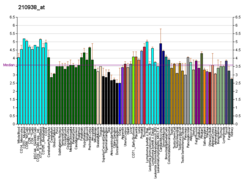Top Qs
Timeline
Chat
Perspective
PDX1
A protein involved in the pancreas and duodenum differentiation From Wikipedia, the free encyclopedia
Remove ads
PDX1 (pancreatic and duodenal homeobox 1), also known as insulin promoter factor 1, is a transcription factor in the ParaHox gene cluster.[5] In vertebrates, Pdx1 is necessary for pancreatic development, including β-cell maturation, and duodenal differentiation. In humans this protein is encoded by the PDX1 gene, which was formerly known as IPF1.[6][7] The gene was originally identified in the clawed frog Xenopus laevis [8] and is present widely across the evolutionary diversity of bilaterian animals, although it has been lost in evolution in arthropods and nematodes.[5] Despite the gene name being Pdx1, there is no Pdx2 gene in most animals; single-copy Pdx1 orthologs have been identified in all mammals.[9] Coelacanth and cartilaginous fish are, so far, the only vertebrates shown to have two Pdx genes, Pdx1 and Pdx2.[10]
Remove ads
Remove ads
Function
Summarize
Perspective
Pancreatic development
In pancreatic development, Pdx1 is expressed by a population of cells in the posterior foregut region of the definitive endoderm, and Pdx1+ epithelial cells give rise to the developing pancreatic buds, and eventually, the whole of the pancreas—its exocrine, endocrine, and ductal cell populations.[11] Pancreatic Pdx1+ cells first arise at mouse embryonic day 8.5-9.0 (E8.5-9.0), and Pdx1 expression continues until E12.0-E12.5.[12] Homozygous Pdx1 knockout mice form pancreatic buds but fail to develop a pancreas,[13] and transgenic mice in which tetracycline application results in death of Pdx1+ cells are almost completely apancreatic if doxycycline (tetracycline derivative) is administered throughout the pregnancy of these transgenic mice, illustrating the necessity of Pdx1+ cells in pancreatic development.[12]
Pdx1 is accepted as the earliest marker for pancreatic differentiation, with the fates of pancreatic cells controlled by downstream transcription factors.[13] The initial pancreatic bud is composed of Pdx1+ pancreatic progenitor cells that co-express Hlxb9, Hnf6, Ptf1a and NKX6-1. These cells further proliferate and branch in response to FGF-10 signaling. Afterwards, differentiation of the pancreatic cells begins; a population of cells has Notch signaling inhibited, and subsequently, expresses Ngn3. This Ngn3+ population is a transient population of pancreatic endocrine progenitors that gives rise to the α, β, Δ, PP, and ε cells of the islets of Langerhans.[12] Other cells will give rise to the exocrine and ductal pancreatic cell populations.
β-cell maturation and survival
The final stages of pancreas development involves the production of different endocrine cells, including insulin-producing β-cells and glucagon-producing α-cells. Pdx1 is necessary for β-cell maturation: developing β-cells co-express Pdx1, NKX6-1, and insulin, a process that results in the silencing of MafB and the expression of MafA, a necessary switch in maturation of β-cells.[11] At this stage of pancreas development, the experimental decrease in the expression of Pdx1 results in a production of a smaller number of β-cells and an associated increase in the number of α-cells.[14]
In the mature pancreas, Pdx1 expression seems to be required for the maintenance and survival of β-cells. For instance, experimentally reducing the level of Pdx1 expression at this stage makes β-cells produce higher amounts of glucagon,[15] suggesting that Pdx1 inhibits the conversion of β-cells into α-cells. Furthermore, Pdx1 appears to be important in mediating the effect of insulin on the apoptotic programmed cell death of β-cells: a small concentration of insulin protects β-cells from apoptosis, but not in cells where Pdx1 expression has been inhibited.[16][17]
Duodenum
Pdx1 is necessary for the development of the proximal duodenum and maintenance of the gastro-duodenal junction.[18] Duodenal enterocytes, Brunner's glands and entero-endocrine cells (including those in the gastric antrum) are dependent on Pdx1 expression. It is a ParaHox gene, which together with Sox2 and Cdx2, determines the correct cellular differentiation in the proximal gut.[18] In mature mice duodenum, several genes have been identified which are dependent on Pdx1 expression and include some affecting lipid and iron absorption.[19]
Remove ads
Pathology
Experiments in animal models have shown that a reduction in Pdx1 expression can cause symptoms that are characteristic of Diabetes mellitus type 1 and Diabetes mellitus type 2.[20] Furthermore, expression of Pdx1 is lost in gastric cancers, suggesting a role for the gene as a tumor suppressor.[21] Maturity onset diabetes of the young (Type 4) can be caused by heterozygous mutations in Pdx1.[22][23] The fat sand rat Psammomys obesus, a species with susceptibility to Diabetes mellitus type 2 symptoms, has a highly divergent Pdx1 gene sequence compared with other mammals.[24]
Remove ads
Interactions
References
Further reading
External links
Wikiwand - on
Seamless Wikipedia browsing. On steroids.
Remove ads







